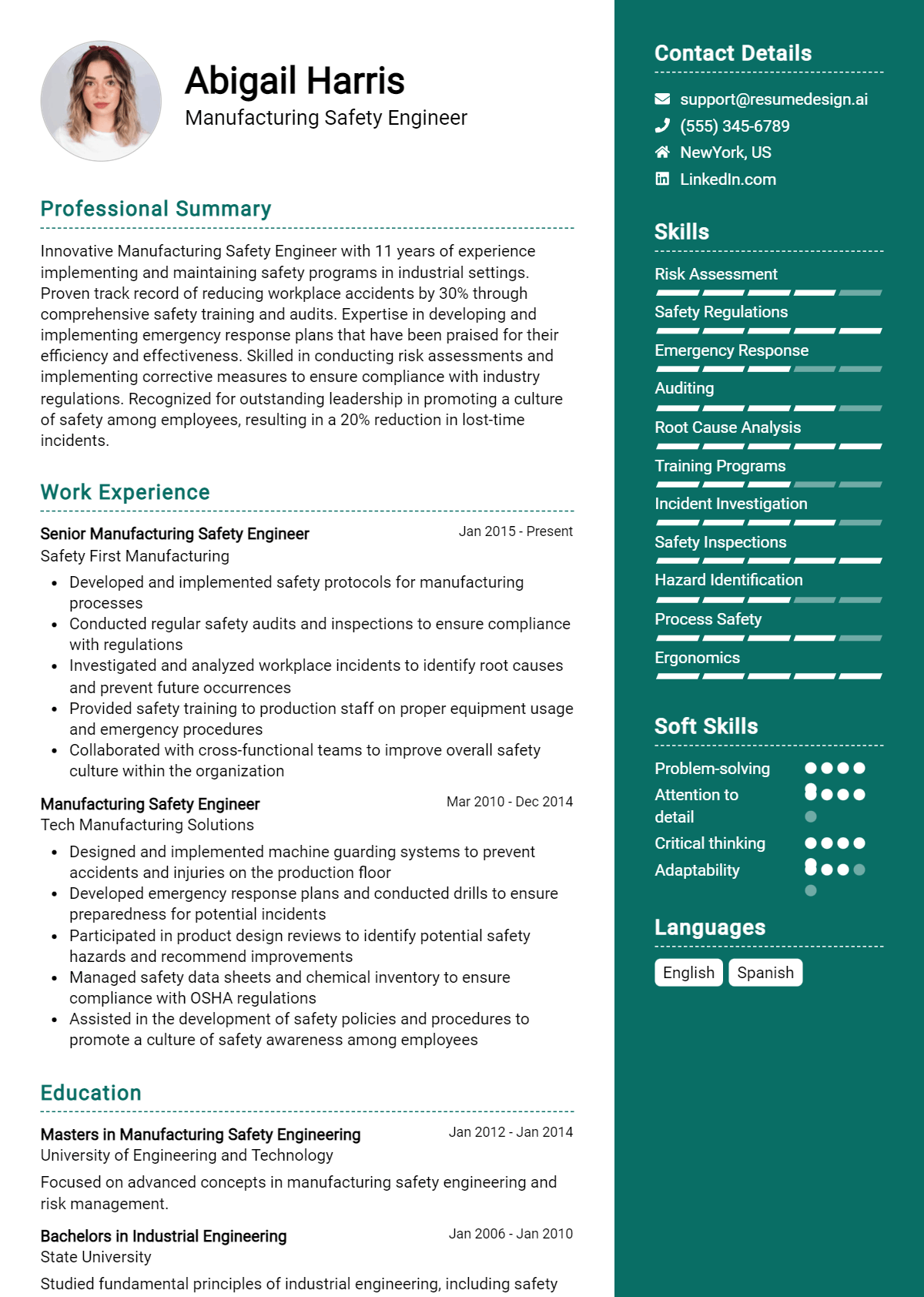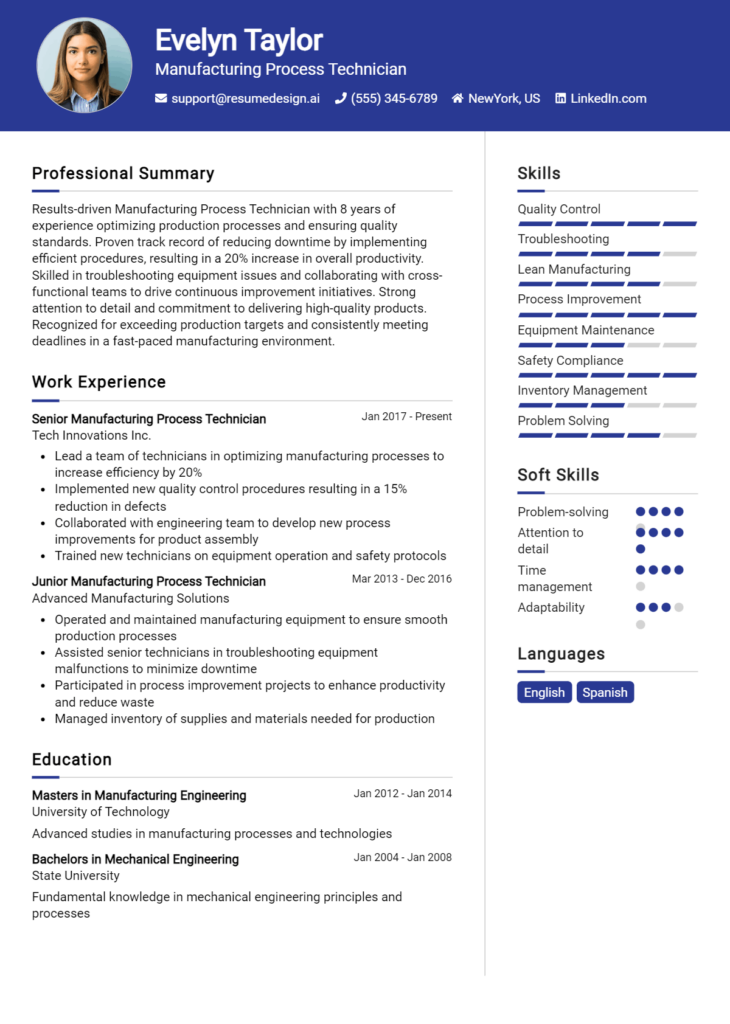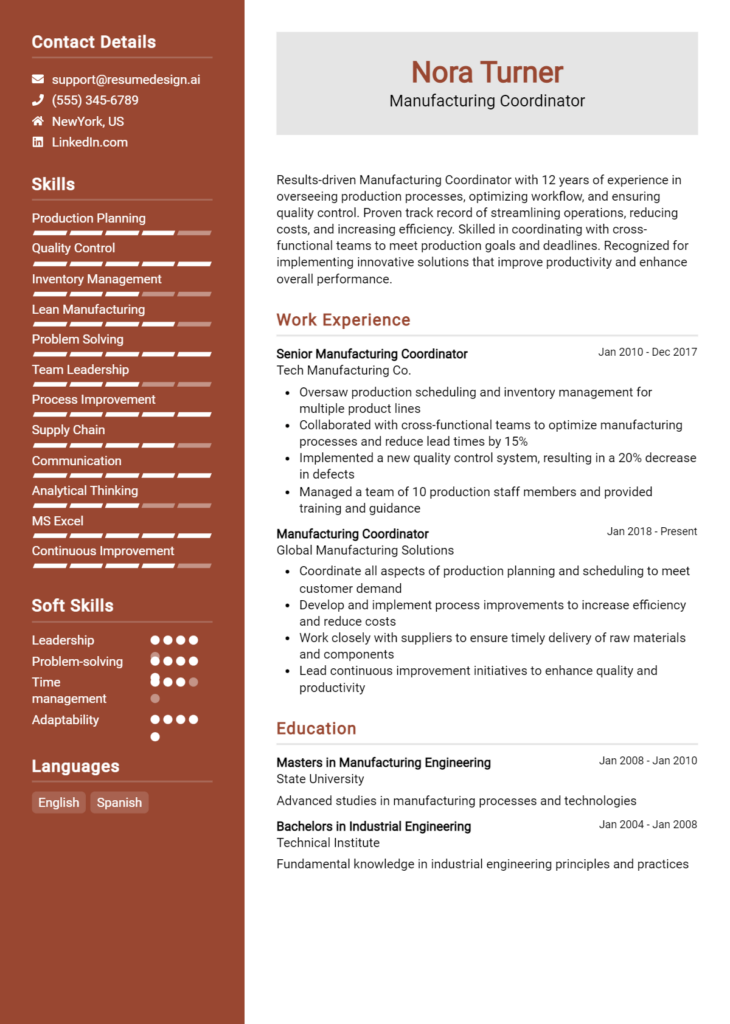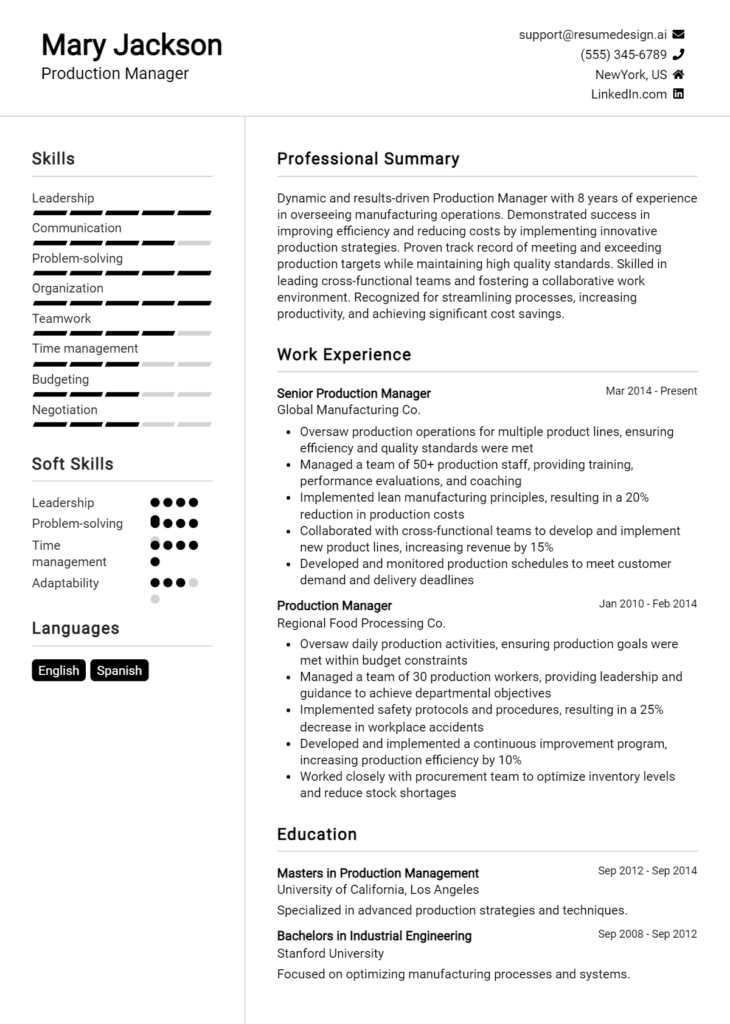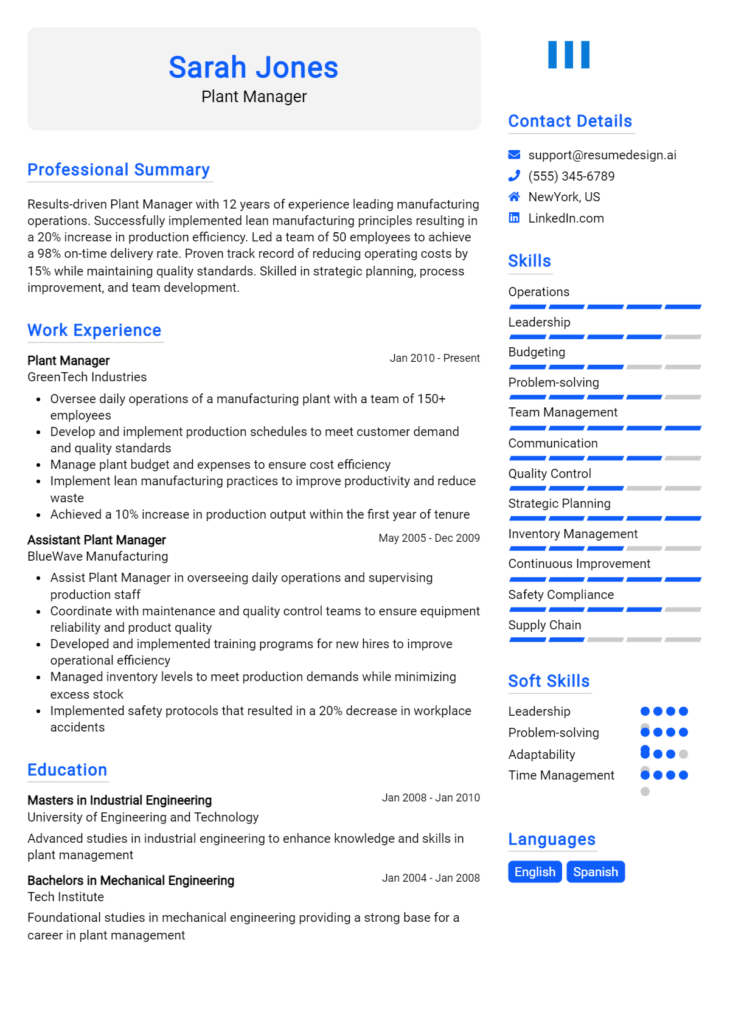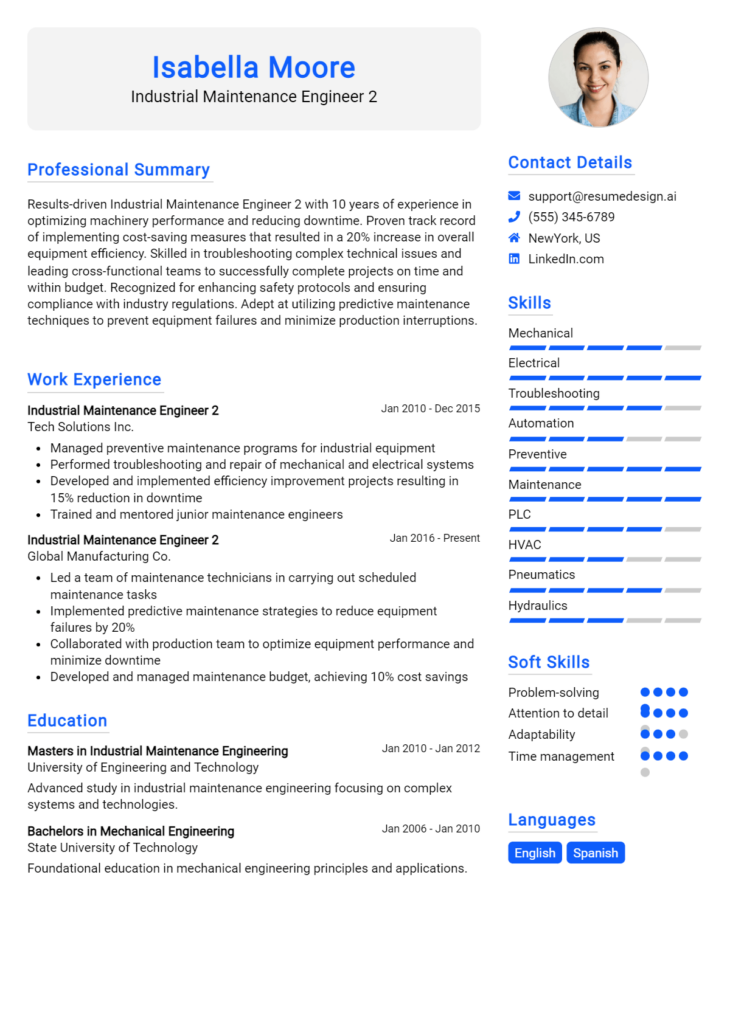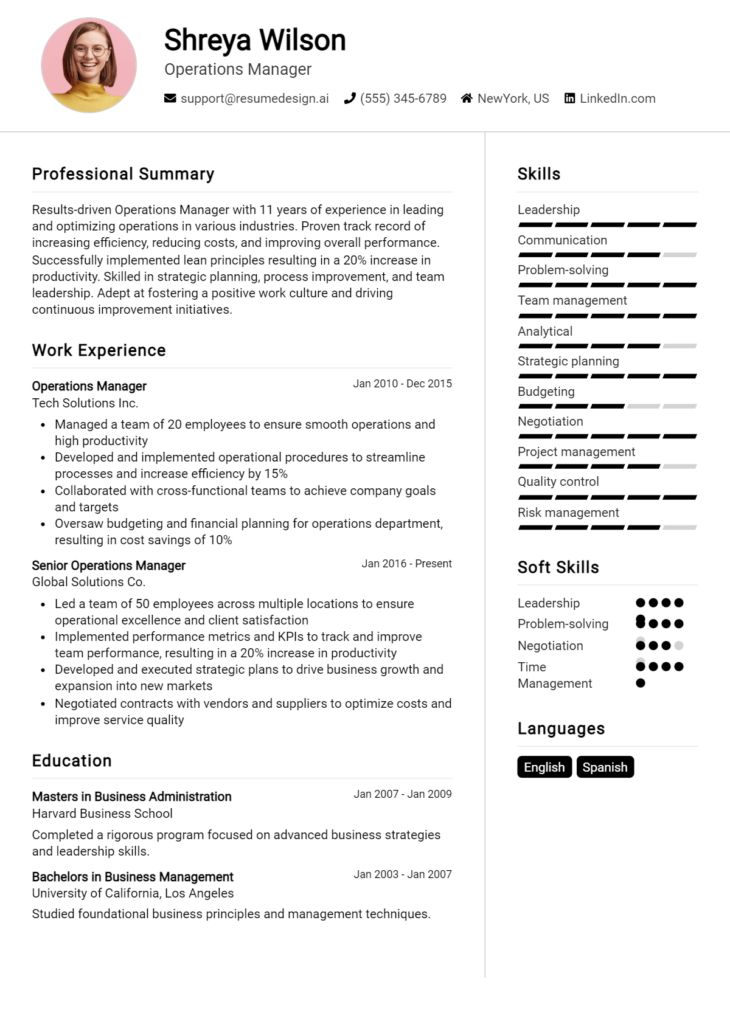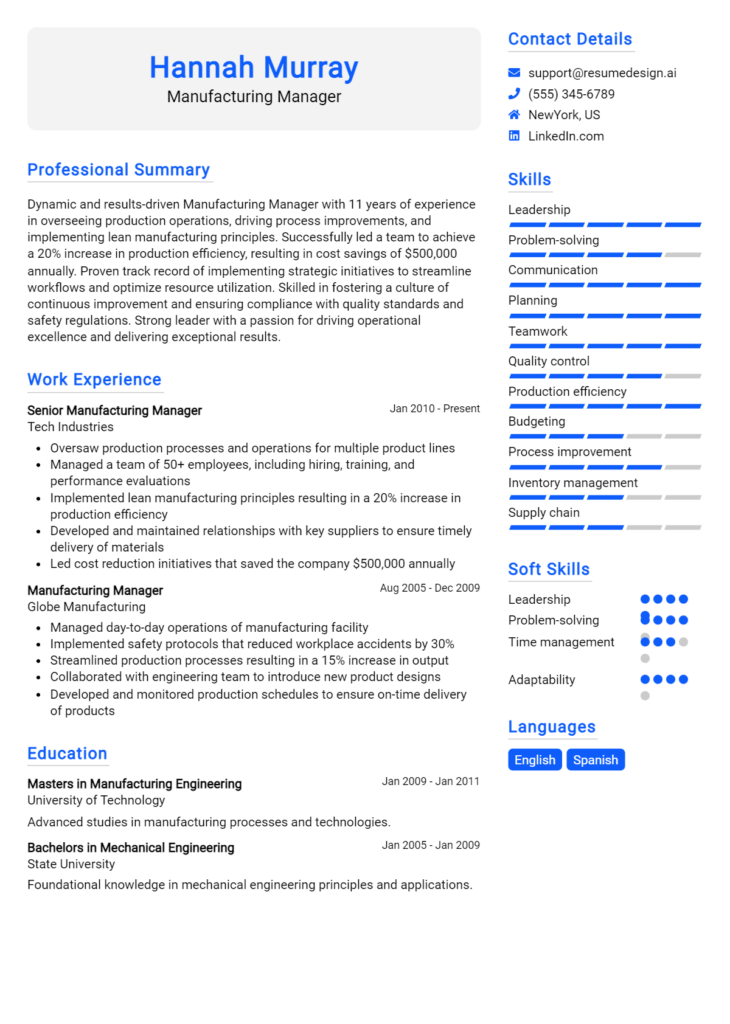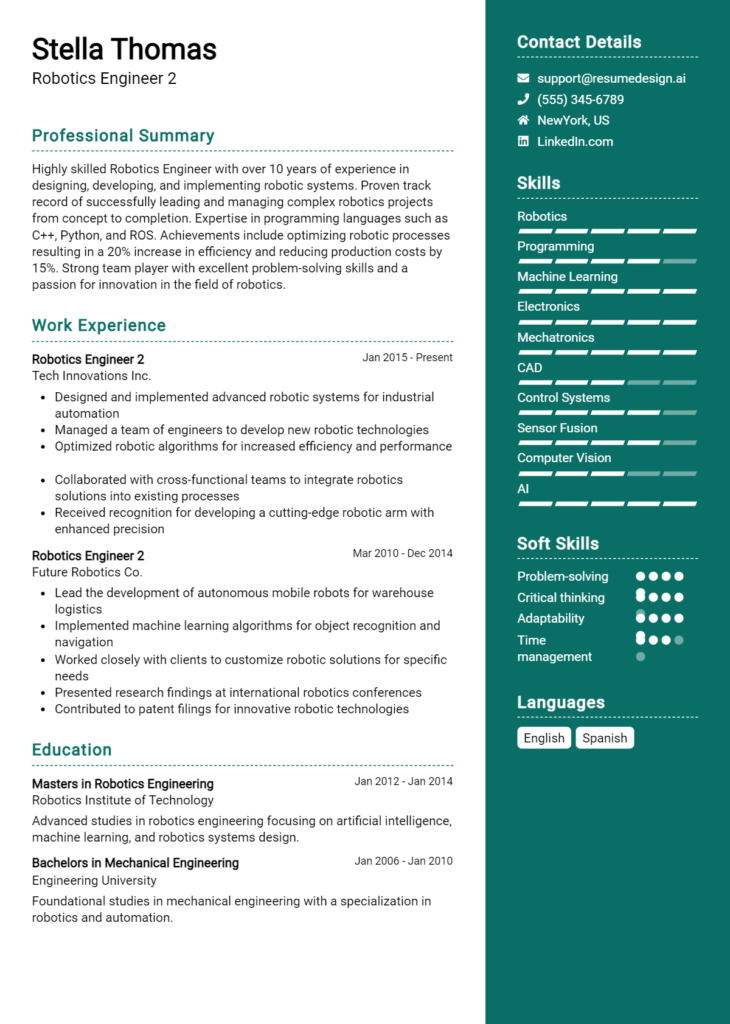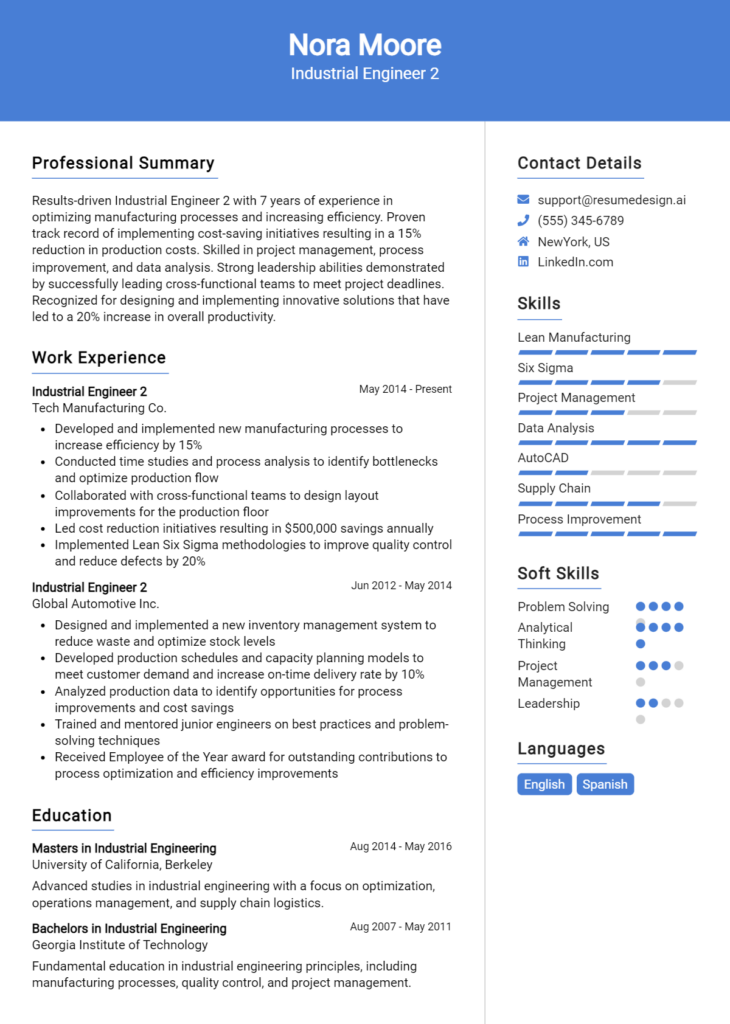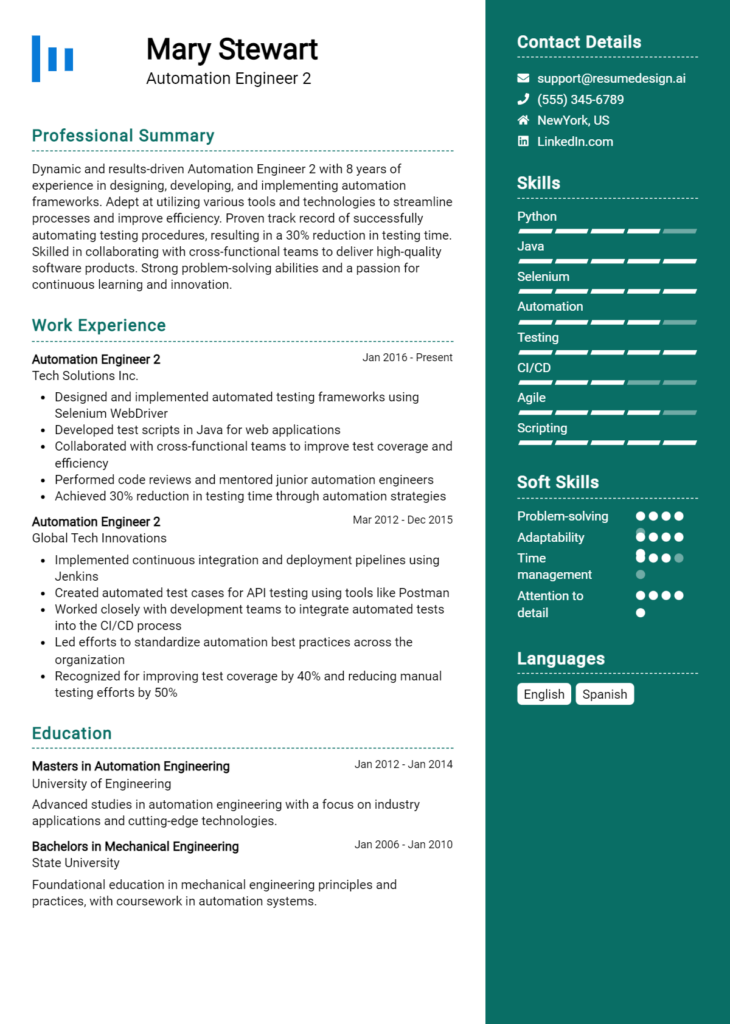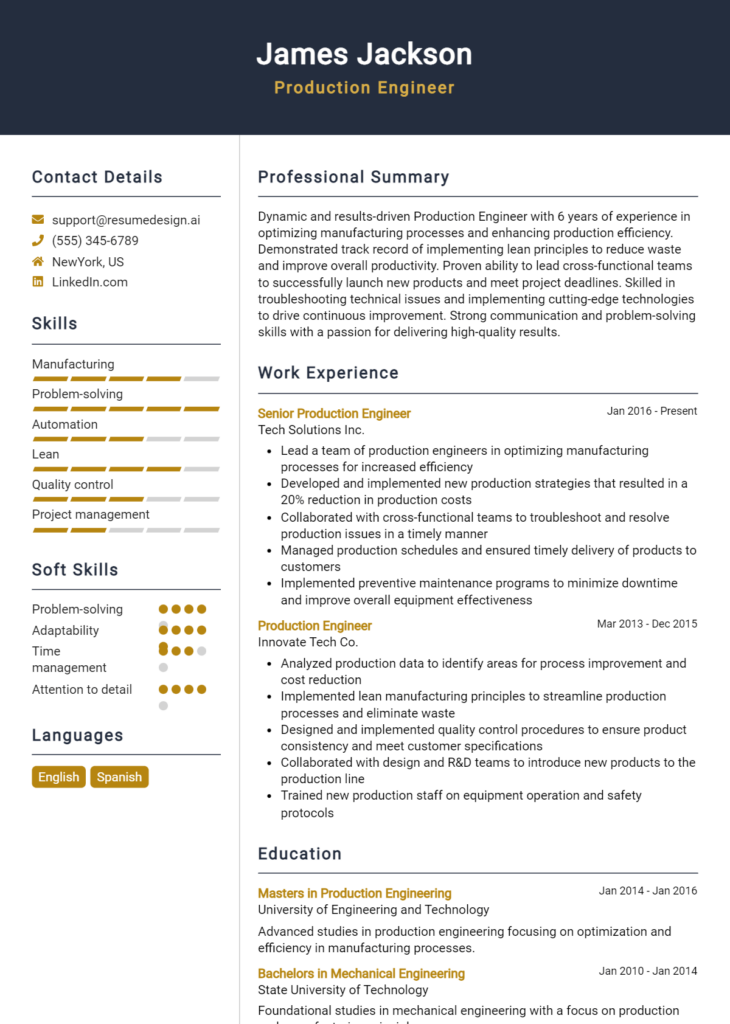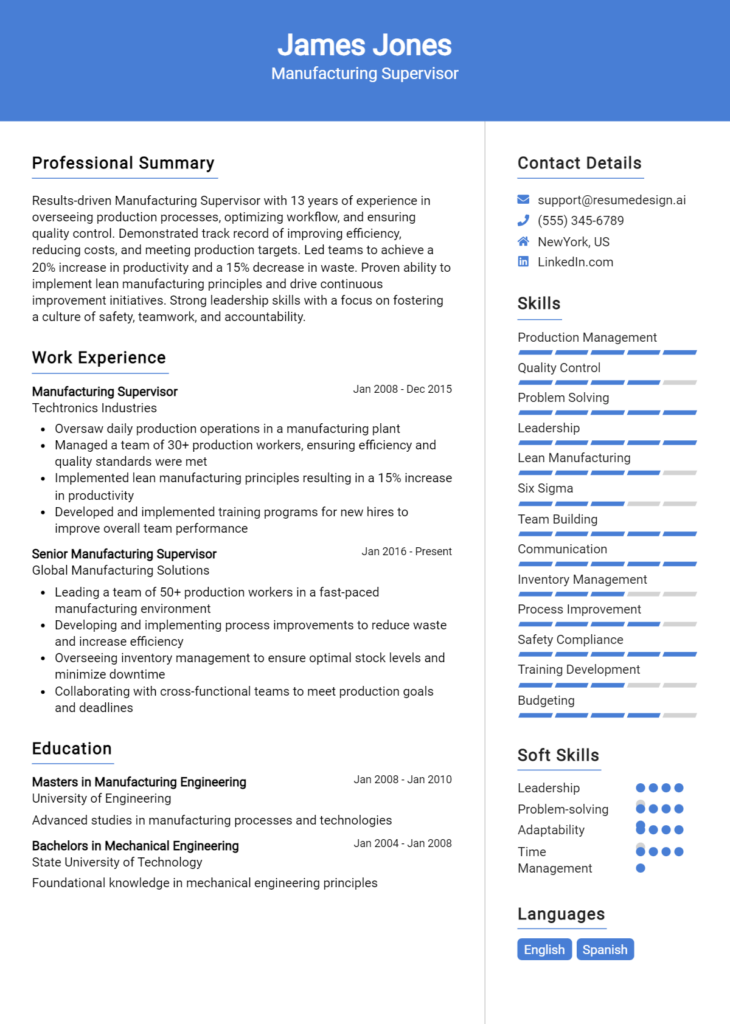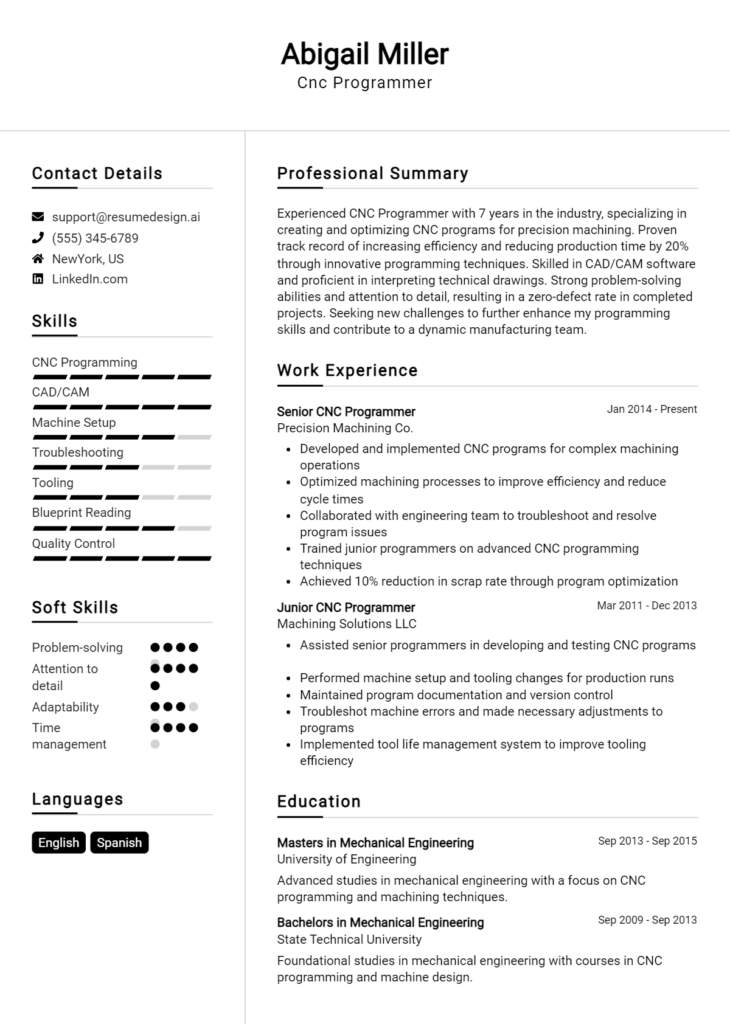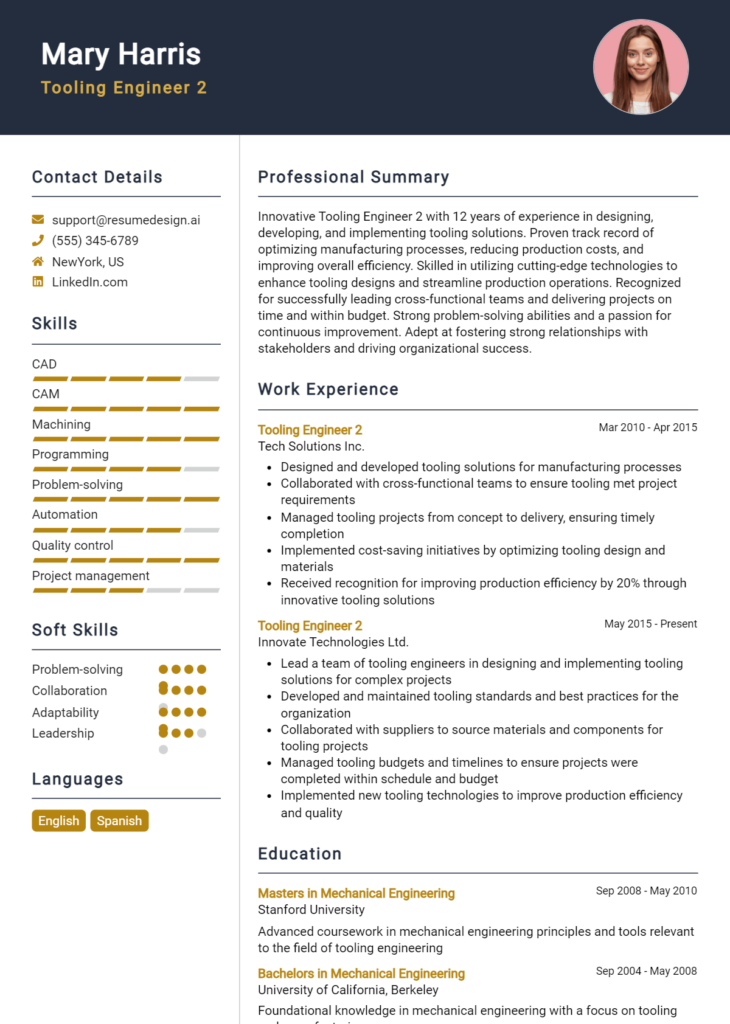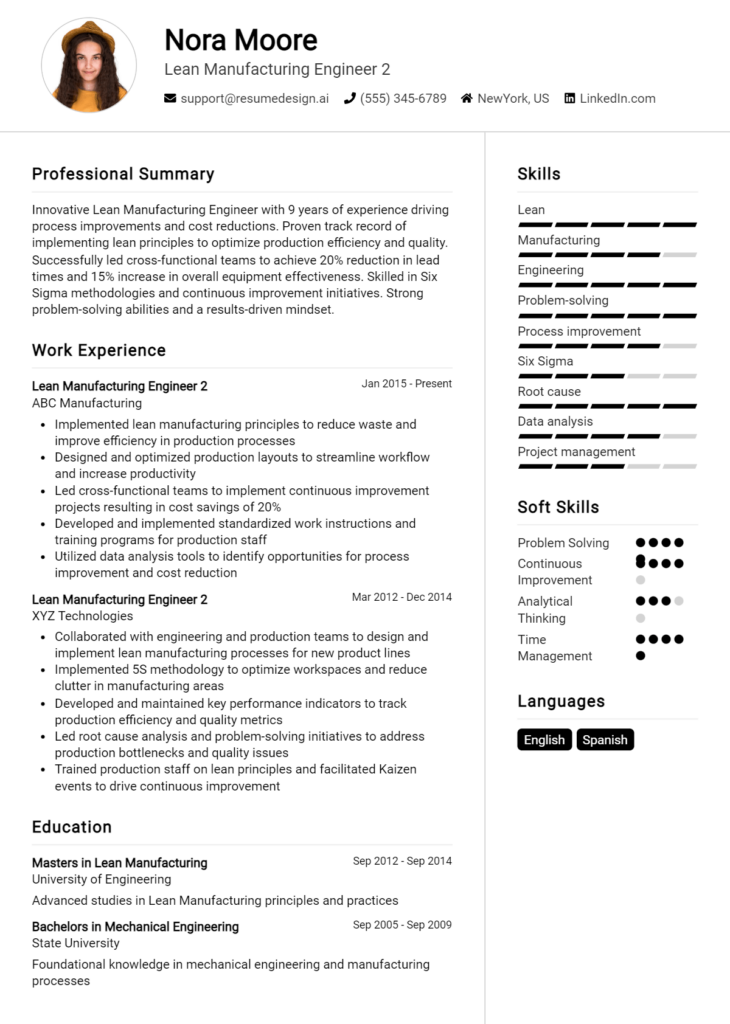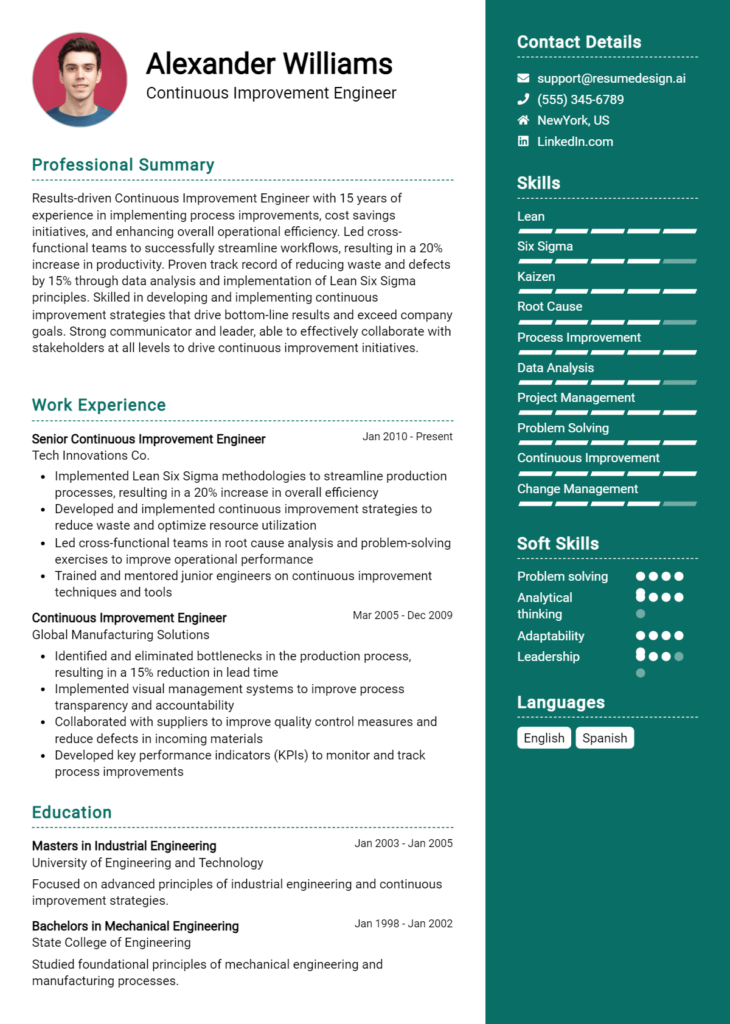Manufacturing Safety Engineer Core Responsibilities
A Manufacturing Safety Engineer plays a crucial role in ensuring workplace safety by identifying hazards, conducting risk assessments, and implementing safety protocols. This professional bridges various departments, including production, engineering, and human resources, to foster a culture of safety. Essential skills include technical expertise in safety regulations, operational insight into manufacturing processes, and strong problem-solving abilities. These competencies contribute to organizational goals by minimizing risks and enhancing employee well-being. A well-structured resume effectively highlights these qualifications, showcasing the candidate's readiness to make a positive impact.
Common Responsibilities Listed on Manufacturing Safety Engineer Resume
- Conduct regular safety audits and inspections to identify hazards
- Develop and implement safety training programs for employees
- Collaborate with cross-functional teams to improve safety practices
- Investigate accidents and incidents to determine root causes
- Ensure compliance with health and safety regulations
- Prepare and maintain safety documentation and reports
- Analyze safety data and trends to recommend improvements
- Monitor the effectiveness of safety policies and procedures
- Facilitate safety meetings and promote a safety-first culture
- Provide technical support for safety equipment and systems
- Implement emergency response plans and procedures
- Stay updated on industry standards and regulatory changes
High-Level Resume Tips for Manufacturing Safety Engineer Professionals
In the competitive field of Manufacturing Safety Engineering, a well-crafted resume is paramount for making a strong first impression on potential employers. Your resume serves as a key marketing tool that not only highlights your skills and achievements but also reflects your professionalism and attention to detail—qualities that are essential in ensuring workplace safety. Given the critical nature of this role, your resume must effectively communicate your expertise in safety protocols, risk assessments, and regulatory compliance. This guide will provide practical and actionable resume tips specifically tailored for Manufacturing Safety Engineer professionals, helping you stand out in a crowded job market.
Top Resume Tips for Manufacturing Safety Engineer Professionals
- Tailor your resume to each job description by incorporating relevant keywords and phrases.
- Highlight your experience in safety audits, risk assessments, and incident investigations.
- Quantify your achievements, such as reductions in workplace accidents or improvements in compliance rates.
- Showcase your knowledge of industry regulations, such as OSHA standards and ISO certifications.
- Include specific safety programs or initiatives you have implemented and their outcomes.
- Emphasize your technical skills, including proficiency in safety management software and data analysis tools.
- Demonstrate your ability to collaborate with cross-functional teams to enhance safety culture.
- List any relevant certifications, such as Certified Safety Professional (CSP) or Occupational Health and Safety Technician (OHST).
- Use a clean, professional format that makes it easy for hiring managers to quickly identify your key qualifications.
- Incorporate a strong summary statement at the top of your resume that encapsulates your experience and value proposition.
By implementing these tips, you can significantly increase your chances of landing a job in the Manufacturing Safety Engineer field. A well-structured and tailored resume not only showcases your qualifications but also demonstrates your commitment to safety and excellence, making you a desirable candidate in the eyes of potential employers.
Why Resume Headlines & Titles are Important for Manufacturing Safety Engineer
In the competitive field of manufacturing safety engineering, a well-crafted resume headline or title plays a crucial role in capturing the attention of hiring managers. A strong headline serves as a powerful first impression, summarizing a candidate's key qualifications in a succinct and impactful manner. It should be concise, relevant, and directly related to the job being applied for, allowing hiring managers to quickly understand the candidate's strengths and suitability for the role. An effective resume headline can make the difference between getting noticed or being overlooked in a sea of applicants.
Best Practices for Crafting Resume Headlines for Manufacturing Safety Engineer
- Keep it concise: Aim for one to two impactful phrases that summarize your qualifications.
- Be role-specific: Tailor your headline to reflect the specific position you are applying for.
- Highlight key strengths: Include your most relevant skills or achievements that align with the job description.
- Use action words: Start with strong action verbs to convey your capabilities and proactive approach.
- Avoid jargon: Use clear and straightforward language that is easily understood by hiring managers.
- Reflect your experience level: Mention your years of experience or expertise to establish credibility.
- Make it compelling: Use language that draws interest and encourages the reader to learn more about you.
- Update regularly: Revise your headline for each application to ensure it aligns with the specific job requirements.
Example Resume Headlines for Manufacturing Safety Engineer
Strong Resume Headlines
Certified Manufacturing Safety Engineer with 10+ Years of Experience in Risk Management
Proven Track Record in Implementing Safety Protocols and Reducing Workplace Incidents
Expert in OSHA Compliance and Safety Training Programs for Manufacturing Facilities
Weak Resume Headlines
Manufacturing Engineer
Safety Professional
Looking for Opportunities in Safety
Strong resume headlines are effective because they precisely convey the candidate’s relevant qualifications and achievements, making it easy for hiring managers to see their value at a glance. They stand out due to their specificity and clarity, directly addressing the needs of the position. In contrast, weak headlines fail to impress because they lack detail and focus. Generic titles do not highlight the candidate's unique strengths or experiences, causing them to blend into the pool of applicants rather than stand out.
Writing an Exceptional Manufacturing Safety Engineer Resume Summary
A well-crafted resume summary is crucial for a Manufacturing Safety Engineer as it serves as the first impression for hiring managers. This brief but impactful section can quickly capture attention by showcasing essential skills, relevant experience, and notable accomplishments tailored to the specific job. A strong summary not only highlights a candidate's qualifications but also demonstrates their understanding of the role and industry. By being concise and direct, it sets the tone for the rest of the resume, inviting the reader to learn more about the applicant's capabilities and fit for the position.
Best Practices for Writing a Manufacturing Safety Engineer Resume Summary
- Quantify achievements to demonstrate impact, such as reduction in incidents or cost savings.
- Focus on key skills relevant to the manufacturing safety field, such as risk assessment and regulatory compliance.
- Tailor the summary to align with the specific job description and requirements.
- Use strong action verbs to convey a sense of accomplishment and proactivity.
- Highlight certifications or specialized training that are pertinent to the role.
- Keep the summary concise, ideally within 3-5 sentences, to maintain the reader's attention.
- Incorporate industry-specific terminology to demonstrate familiarity with the field.
- Showcase a blend of technical and soft skills, emphasizing both safety expertise and teamwork capabilities.
Example Manufacturing Safety Engineer Resume Summaries
Strong Resume Summaries
Safety-focused Manufacturing Engineer with over 8 years of experience in implementing safety protocols and reducing workplace incidents by 30%. Proven track record in leading safety audits and training programs that improved compliance with OSHA standards across multiple facilities.
Dedicated Manufacturing Safety Engineer skilled in hazard analysis and risk management, successfully decreasing accident rates by 25% through the development of comprehensive training programs and safety initiatives. Certified in Six Sigma and Lean Manufacturing principles to enhance operational safety.
Results-oriented Safety Engineer with a decade of experience in the manufacturing sector, specializing in environmental health and safety compliance. Achieved a 40% reduction in safety violations while ensuring adherence to all regulatory requirements and improving employee safety engagement.
Weak Resume Summaries
Experienced engineer looking for a position to improve safety in manufacturing settings.
Safety Engineer with some experience and a general understanding of safety protocols in manufacturing.
The strong resume summaries are effective because they include quantifiable outcomes, specific skills, and are directly relevant to the role of a Manufacturing Safety Engineer. They highlight measurable achievements, certifications, and a clear understanding of safety practices in the industry. In contrast, the weak resumes lack detail, specificity, and fail to convey the candidate's impact or align with the job requirements, making them less compelling to hiring managers.
Work Experience Section for Manufacturing Safety Engineer Resume
The work experience section of a Manufacturing Safety Engineer resume is crucial as it provides a platform for candidates to showcase their technical skills, leadership abilities, and contributions to delivering high-quality products in a safe manufacturing environment. This section allows applicants to demonstrate their hands-on experience in implementing safety protocols, conducting risk assessments, and leading teams in compliance with industry standards. By quantifying achievements, such as improvements in safety metrics or reductions in incident rates, candidates can illustrate their impact on the organization and align their experience with the expectations of potential employers.
Best Practices for Manufacturing Safety Engineer Work Experience
- Highlight relevant certifications and training related to safety engineering.
- Use action verbs to describe responsibilities and achievements effectively.
- Quantify results where possible (e.g., reduced incidents by X%, improved compliance rates by Y%).
- Showcase collaboration with cross-functional teams to enhance safety measures.
- Detail specific safety projects you've led or contributed to, including outcomes.
- Align your experience with industry standards and regulations.
- Include leadership roles and team management experiences to emphasize your ability to guide others.
- Focus on continuous improvement initiatives you have implemented successfully.
Example Work Experiences for Manufacturing Safety Engineer
Strong Experiences
- Led a safety initiative that resulted in a 30% reduction in workplace incidents over 12 months through the implementation of new training protocols and safety audits.
- Collaborated with engineering teams to redesign equipment layouts, improving operational safety and reducing risk assessments time by 25%.
- Developed and executed a comprehensive safety management system that increased compliance with OSHA standards from 75% to 95% in one year.
- Managed a cross-departmental team to conduct monthly safety drills, resulting in a 40% increase in employee participation and awareness of emergency procedures.
Weak Experiences
- Assisted with safety training sessions.
- Worked on safety audits and inspections occasionally.
- Involved in team meetings discussing safety issues.
- Monitored safety compliance in the workplace.
The examples listed as strong experiences demonstrate specific, quantifiable achievements and illustrate the candidate's technical leadership and ability to work collaboratively with teams to improve safety outcomes. In contrast, the weak experiences lack detail and measurable results, making them less impactful and failing to convey the candidate's true capabilities in a manufacturing safety role.
Education and Certifications Section for Manufacturing Safety Engineer Resume
The Education and Certifications section of a Manufacturing Safety Engineer resume plays a crucial role in establishing the candidate's qualifications and expertise in the field. This section serves not only to highlight the academic background of the applicant but also to showcase industry-relevant certifications and ongoing educational pursuits. By detailing relevant coursework, certifications, and specialized training, candidates can significantly enhance their credibility and demonstrate alignment with the job requirements, making them stand out in a competitive job market.
Best Practices for Manufacturing Safety Engineer Education and Certifications
- Include only relevant degrees and certifications that pertain to safety engineering or related fields.
- Clearly list the name of the institution, degree obtained, and date of completion for educational qualifications.
- Highlight certifications from recognized organizations, such as the Board of Certified Safety Professionals (BCSP) or the National Safety Council (NSC).
- Detail any specialized training related to manufacturing safety, risk management, or regulatory compliance.
- Incorporate relevant coursework that pertains directly to safety engineering, such as Occupational Safety and Health Administration (OSHA) standards.
- Use bullet points for clarity and to make the section easy to read.
- Stay current by listing any recent certifications or training completed within the last few years.
- Emphasize advanced degrees or specialized certifications that can set you apart from other candidates.
Example Education and Certifications for Manufacturing Safety Engineer
Strong Examples
- Master of Science in Industrial Engineering, University of Michigan, 2021
- Certified Safety Professional (CSP), Board of Certified Safety Professionals, 2022
- OSHA Authorized Trainer for General Industry, National Safety Council, 2023
- Bachelor of Science in Environmental Health and Safety, Texas A&M University, 2019
Weak Examples
- Associate Degree in General Studies, Community College, 2015
- Certification in Basic First Aid, American Red Cross, 2016
- High School Diploma, Local High School, 2010
- Certification in Microsoft Office, Online Course, 2020
The examples listed as strong are considered highly relevant and demonstrate a clear alignment with the skills and knowledge required for a Manufacturing Safety Engineer role. They reflect advanced education and recognized certifications that validate the candidate's expertise. Conversely, the weak examples illustrate qualifications that are outdated or unrelated to the manufacturing safety field, which could detract from the candidate’s overall profile. Including strong, relevant credentials is essential for showcasing the necessary qualifications for the position.
Top Skills & Keywords for Manufacturing Safety Engineer Resume
In the competitive field of manufacturing safety, a well-crafted resume that highlights the right skills is essential for standing out to potential employers. A Manufacturing Safety Engineer plays a crucial role in ensuring that safety protocols are adhered to, promoting a safe working environment, and minimizing risks associated with industrial operations. Therefore, showcasing both hard and soft skills on your resume can significantly enhance your chances of landing a job in this vital sector. Whether it's technical expertise or interpersonal abilities, the right combination of skills reflects your capability to contribute effectively to workplace safety and compliance.
Top Hard & Soft Skills for Manufacturing Safety Engineer
Soft Skills
- Attention to Detail
- Problem-Solving Abilities
- Strong Communication Skills
- Team Collaboration
- Leadership and Management Skills
- Adaptability and Flexibility
- Analytical Thinking
- Risk Assessment
- Conflict Resolution
- Time Management
Hard Skills
- Knowledge of OSHA Regulations
- Proficiency in Safety Auditing
- Familiarity with Hazard Analysis Techniques
- Emergency Response Planning
- Use of Safety Management Software
- Data Analysis and Reporting Skills
- Training Development and Delivery
- Incident Investigation Techniques
- Environmental Safety Standards
- Equipment Safety Inspections
Incorporating these skills into your resume, alongside relevant work experience, can significantly bolster your application and position you as a strong candidate for a Manufacturing Safety Engineer role.
Stand Out with a Winning Manufacturing Safety Engineer Cover Letter
I am writing to express my interest in the Manufacturing Safety Engineer position at [Company Name], as advertised on [Job Board/Company Website]. With a Bachelor’s degree in Industrial Engineering and over five years of experience in safety management within manufacturing environments, I am confident in my ability to contribute effectively to your team and ensure a safe and compliant workplace. My background in risk assessment and my proactive approach to safety management align perfectly with your commitment to maintaining the highest safety standards.
In my previous role at [Previous Company Name], I successfully implemented a comprehensive safety training program that reduced workplace accidents by 30% within the first year. I conducted thorough investigations of incidents, identifying root causes and developing corrective actions that not only addressed immediate concerns but also fostered a culture of safety awareness among employees. My ability to collaborate with various departments, from production to human resources, has been instrumental in creating an inclusive approach to safety that engages all personnel in the process.
I am particularly drawn to [Company Name] due to its reputation for innovation and commitment to employee welfare. I admire your recent initiatives aimed at enhancing workplace safety through technology and process improvements. I am eager to bring my expertise in hazard identification and compliance with OSHA regulations to your organization, helping to further advance these initiatives. My analytical skills and attention to detail enable me to identify potential risks and implement effective solutions quickly, ensuring that safety remains a top priority in all manufacturing processes.
I look forward to the opportunity to discuss how my background, skills, and enthusiasms align with the goals of [Company Name]. Thank you for considering my application. I am excited about the possibility of contributing to your team and furthering the outstanding safety standards that [Company Name] is known for. Please feel free to contact me at [Your Phone Number] or [Your Email] to schedule a discussion.
Common Mistakes to Avoid in a Manufacturing Safety Engineer Resume
When crafting a resume as a Manufacturing Safety Engineer, it’s crucial to present your qualifications and experience in a clear and compelling manner. However, many candidates make common mistakes that can undermine their chances of landing an interview. Avoiding these pitfalls can help ensure that your resume stands out positively to hiring managers in a competitive field. Below are some common mistakes to steer clear of:
Generic Objective Statements: Using a one-size-fits-all objective can come off as insincere. Tailor your objective to reflect your specific interest in the role and how your skills align with the company's needs.
Neglecting Relevant Certifications: Failing to prominently display relevant safety certifications, such as OSHA or Six Sigma, can lead to missed opportunities. Highlight these qualifications clearly, as they are often key requirements for the role.
Vague Job Descriptions: Instead of using generic phrases like "responsible for safety," provide specific examples of your accomplishments and the impact of your work. Use metrics to demonstrate how your efforts improved safety protocols or reduced incidents.
Overlooking Soft Skills: While technical skills are crucial, manufacturing safety engineers also need strong communication and leadership abilities. Failing to mention soft skills can make your resume less compelling.
Ignoring Formatting Consistency: A cluttered or inconsistent format can distract from your qualifications. Ensure that fonts, bullet points, and spacing are uniform throughout the document for a professional appearance.
Using Jargon Without Explanation: While industry-specific terminology can demonstrate expertise, excessive jargon can alienate readers unfamiliar with certain terms. Aim for a balance by explaining key terms briefly.
Omitting Continuous Learning: The field of manufacturing safety is always evolving. Not highlighting your commitment to ongoing education or training can give the impression that you are stagnant in your professional development.
Failing to Tailor for Each Application: Sending out the same resume for multiple positions can diminish your chances. Tailor each resume to highlight the skills and experiences that best match the specific job description.
Conclusion
As a Manufacturing Safety Engineer, your role is critical in ensuring a safe working environment while maintaining compliance with industry regulations. Throughout this article, we have discussed the essential skills and qualifications necessary for this position, including risk assessment, hazard identification, and the implementation of safety protocols. We also highlighted the importance of effective communication and teamwork in fostering a culture of safety within an organization.
To succeed in this competitive field, it’s crucial to present a strong resume that showcases your experience and expertise. Now is the perfect time to review your Manufacturing Safety Engineer resume and make sure it reflects your accomplishments and skills effectively.
Take advantage of the various tools available to enhance your job application materials. Explore resume templates to find a design that suits your style, utilize the resume builder for a polished finish, check out resume examples for inspiration, and don’t forget to create a compelling cover letter using our cover letter templates.
Investing time in refining your resume can significantly increase your chances of landing your desired position in the manufacturing safety field. Start today and take the next step toward advancing your career!

